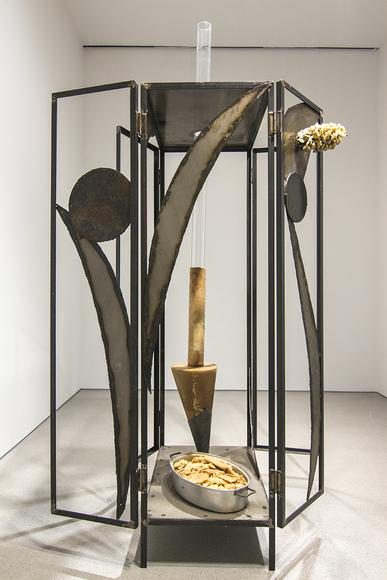ART-PRESENTATION: Mario Merz-Works from the 1980s
 A major figure in the Arte Povera Movement, the Italian artist Mario Merz’s work combines a fascination with the material and metaphorical qualities of natural objects with ideas regarding infinity and repetition. Much of his work was based around the Fibonacci sequence, a formula often used to express mathematical sequences in nature.
A major figure in the Arte Povera Movement, the Italian artist Mario Merz’s work combines a fascination with the material and metaphorical qualities of natural objects with ideas regarding infinity and repetition. Much of his work was based around the Fibonacci sequence, a formula often used to express mathematical sequences in nature.
By Efi Michalarou
Photo: Sperone Westwater Gallery Archive
The exhibition “Mario Merz: Works from the 1980s” features works from the early ‘80s in a number of the artist’s best known formats: notably tables, shelters, and expansive unstretched canvases that incorporate three-dimensional attachments. The works on view demonstrate Merz’s expressive range and central thematic concerns such as issues of natural history, energy and growth, and sustenance and shelter. Through the integration of industrial and organic materials, the displayed works suggest a vibrant interplay between human and animal realms. Merz’s work is heavily informed in both form and content by the logic of the Fibonacci sequence (the mathematic sequence in which each integer is determined by the sum of the two preceding numbers). Merz incorporates these natural networks to relate both literally and metaphorically to issues of social organization. “I saw that it was possible to use Fibonacci’s progression as a linear method, and to apply it rather than simply describe it. It could particularly be applied and used against a philosophy in which the mass is seen to exist a priori. It could be used analytically to a distinguish between the single unit and the mass, rather than taking mass in itself as an all-absorbing organism”. The Fibonacci sequence finds symbolic expression in the spiral form that recurs throughout Merz’s work. “Tavola a spirale”, 1982, ties the sense of natural profusion directly to the table’s symbolic importance as a place of gathering. Fresh fruits and vegetables are arranged on these tables, at times massed into bountiful piles, at times organized into neat patterns. In “Quattro tavole in forma di foglie di magnolia”, (1985), natural beeswax forms the surface of the welded steel from which various organic and manmade elements are suspended. The tables themselves assume the shape of magnolia leaves, which grow according to a Fibonacci progression, and suggest, like the “Tavola a spirale”, a potentially endless proliferation. With their constantly changing elements, Merz’s tables are perhaps the most radically open of the artist’s works, and gesture toward the broader sense of community the artist sought to engender. The wide range of materials, forms, and concepts employed in Merz’s work also suggests a nomadic association to nature, “Bisonti” (1982), is a canvas that depicts two bison beneath a colorful arc bearing the faintly scrawled line. In “Noi giriamo intorno alle case o le case girano intorno a noi?” (1982), vellum paintings with vivid yet ambiguous animal motifs are mounted on bamboo poles in the form of a lantern-like primitive structure. Anchored to the ground by clay feet, the work opens outward to embrace the conditions of its own display, expressing Merz’s notion that “Painting is a thingly process, not subject to photographic consumption”.
Info: Sperone Westwater Gallery, 257 Bowery New York, Duration 30/4-18/6/16, Days & Hours: Tue-Sat 10:00-18:00, www.speronewestwater.com



